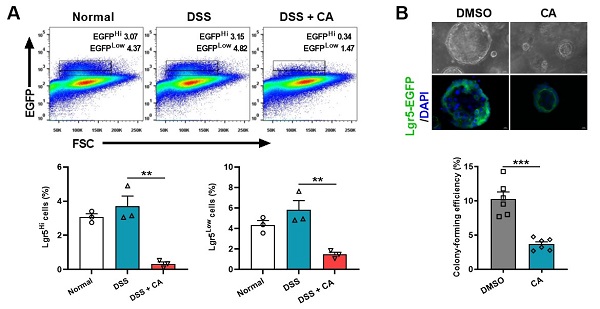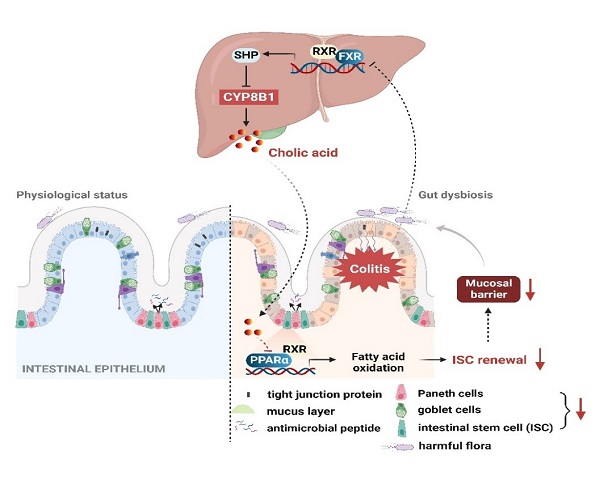Researchers Reveal Molecular Mechanism of Hepatic Bile Acid Metabolism Affecting Intestinal Barrier Renewal
Intestinal epithelial barriers, that include both physical and chemical barriers, segregate gut commensal microbes and the host immunity to maintain intestinal homeostasis. Epithelial cell damage and subsequent barrier dysfunction are the prominent features of inflammatory bowel disease (IBD). Bile acids are the final products of cholesterol catabolism, acting as amphiphilic emulsifiers facilitating the absorption of lipids from intestine and biliary excretion of cholesterol and phospholipids. They mainly modulate farnesoid X receptor (FXR) and G protein-coupled bile acid receptor 1 (GPBAR1, TGR5) to regulate bile acid enterohepatic circulation, energy metabolism, and immune function. Previous studies have shown that BAs are important regulators of intestinal epithelial barrier function, but the underlying mechanism has not been elucidated.
In a study published in Cell Stem Cell on Sept 1st, a team of researchers led by XIE Cen and HE Shijun from the Shanghai Institute of Materia Medica (SIMM) of the Chinese Academy of Sciences, in collaboration with the groups led by LIU Weiwei from Shanghai University of Traditional Chinese Medicine, and Frank J. Gonzalez from National Institutes of Health, revealed the molecular mechanisms of hepatic bile acid metabolism affecting intestinal barrier function.
The researchers found that bile acid metabolism was dysregulated in patients with active ulcerative colitis and experimental colitic mice, with significant elevation of cholic acid (CA) levels and upregulation of sterol 12-α-hydroxylase (CYP8B1), a metabolic enzyme in the classical bile acid synthesis pathway in liver. Exogenous CA supplementation or CYP8B1 overexpression developed more severe colitis with compromised repair of the mucosal barrier, whereas Cyp8b1-knockdown mice were resistant to colitis.
The intestine epithelium self-renewed rapidly which was dictated by intestinal stem cells (ISCs) to counteract intestinal damage and mucosal barrier dysfunction. In order to understand the mechanism of hepatic CYP8B1-CA metabolic axis affecting ISCs renewal, the researchers isolated intestinal crypts and ISCs of colitic mice for in vitro culture, and found that CA at pathological concentrations significantly worsened the budding and organoid-forming ability of organoids, and directly inhibit the proliferation of Lgr5+ ISCs.

Intriguingly, the effects of CA on ISCs were independent on FXR and TGR5, two classic bile acid receptors. In further RNA-seq and metabolomics analysis, CA inhibited multiple metabolic pathways, especially the peroxisome proliferator activated receptor (PPAR) signaling pathway in crypts. Using intestinal-specific Ppara knockout mice, the researchers demonstrated that CA impaired the regenerative function of Lgr5+ ISCs via repressing PPARα-mediated fatty acid oxidation (FAO).
Finally, obeticholic acid, a potent and selective FXR agonist was chosen to treat experimental colitis. It was found that obeticholic acid significantly suppressed the expression of CYP8B1 in liver, as well as decreased the accumulation of CA in intestine, reprogrammed Lgr5+ ISCs renewal, and thus relieved colitis.
In conclusion, this study established a cross-organ regulatory mechanism in IBD pathogenesis in which the CYP8B1-CA pathway acts as a central node linking liver bile acid metabolism and intestinal epithelial wound healing by coordinating the Lgr5+ ISCs renewal program via the PPARα-FAO pathway. From a therapeutic angle, direct disruption of CYP8B1 or alternatively, activation of FXR with selective and potent agonists in the liver could constitute a promising strategy for IBD treatment by enhancing the regenerative capacity of the intestinal epithelium.

DOI:
https://doi.org/10.1016/j.stem.2022.08.008
CONTACT:
DIAO Wentong
Shanghai Institute of Materia Medica
E-mail: diaowentong@simm.ac.cn




